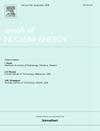金星f上的CoRREx中子谱滤波运动,用于计算与实验的差异解释
IF 1.9
3区 工程技术
Q1 NUCLEAR SCIENCE & TECHNOLOGY
引用次数: 0
摘要
研究反应堆,特别是零功率反应堆,是反应堆设计和部署之间的桥梁。在 SCK CEN 运行的快频谱 VENUS-F 零功率反应堆旨在支持快速重金属冷却反应堆设计的开发。随着时间的推移,观察到模型结果与实验之间存在一些差异,特别是在中子频谱更加表观的地方。为了确定这些差异的根源,进行了 CoRREx 实验:在 VENUS-F 中加载了不同厚度的 B4C 过滤器,以研究表热中子谱与这些差异的相关性。我们介绍了光谱指数(裂变率比)、235U 裂变率遍历和反应性值的测量结果,并将其与使用 JEFF-3.3、ENDF/B-VIII.0、ENDF/B-VIII.1 和 JENDL-4.0u 进行的 Serpent 计算结果进行了比较。CoRREx显示,在活动核中心和外围,Serpent模型在再现实验结果方面的性能相当接近。此外,CoRREx 使用 B4C 中子能谱滤波器并对实验不确定性进行了彻底的传播,从而深入了解了表热中子通量能谱成分对观测差异的最小贡献。CoRREx 表明,观测到的光谱指数计算与实验之间的差异可归因于快中子能谱。Serpent 模型在 235U 裂变率穿越方面显示出良好的性能,但略微低估了滤波反应性的价值。本文章由计算机程序翻译,如有差异,请以英文原文为准。

The CoRREx neutron spectrum filtering campaign at VENUS-F for calculation-to-experiment discrepancy interpretation
Research reactors and particularly zero power reactors serve as bridges between reactor design and deployment. The fast spectrum VENUS-F zero power reactor operated at SCK CEN has been conceived to support the development of fast heavy-metal-cooled reactor designs. Over time, several discrepancies between model results and experiments were observed, especially where the neutron spectrum is more epithermal. To identify their origin, the CoRREx experiment was conducted: BC filters of different thickness were loaded in VENUS-F to investigate the relevance of the epithermal neutron spectrum to those discrepancies. We present measurements of spectral indices (fission rate ratios), U fission rate traverses and reactivity worth and compare them with the results of Serpent calculations using JEFF-3.3, ENDF/B-VIII.0, ENDF/B-VIII.1 and JENDL-4.0u. CoRREx shows that the Serpent model performance in reproducing the experiment results is rather similar in the active core center and periphery. Furthermore, using BC neutron spectrum filters and conducting a thorough propagation of experimental uncertainty CoRREx provides insights on the minimal contribution of the epithermal neutron flux spectrum component to the observed discrepancies. CoRREx indicates that the observed spectral index calculation-to-experiment discrepancy is attributable to the fast neutron spectrum. The Serpent model shows good performance for U fission rate traverses and a slight underestimation of the filter reactivity worth.
求助全文
通过发布文献求助,成功后即可免费获取论文全文。
去求助
来源期刊

Annals of Nuclear Energy
工程技术-核科学技术
CiteScore
4.30
自引率
21.10%
发文量
632
审稿时长
7.3 months
期刊介绍:
Annals of Nuclear Energy provides an international medium for the communication of original research, ideas and developments in all areas of the field of nuclear energy science and technology. Its scope embraces nuclear fuel reserves, fuel cycles and cost, materials, processing, system and component technology (fission only), design and optimization, direct conversion of nuclear energy sources, environmental control, reactor physics, heat transfer and fluid dynamics, structural analysis, fuel management, future developments, nuclear fuel and safety, nuclear aerosol, neutron physics, computer technology (both software and hardware), risk assessment, radioactive waste disposal and reactor thermal hydraulics. Papers submitted to Annals need to demonstrate a clear link to nuclear power generation/nuclear engineering. Papers which deal with pure nuclear physics, pure health physics, imaging, or attenuation and shielding properties of concretes and various geological materials are not within the scope of the journal. Also, papers that deal with policy or economics are not within the scope of the journal.
 求助内容:
求助内容: 应助结果提醒方式:
应助结果提醒方式:


